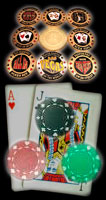IMAGE OF A DYNAMIC, AGGRESSIVE PLAYER
What image are other players likely to have of you if you play a dynamic, aggressive game? (The kind of game this book suggests you play.)
Many of them will likely think you’re a near maniac: a loose, aggressive, weak player. Others will think you’re tough, tricky player.
The reason for this is that most players think of playing in terms of the cards.
They will look at the cards you play and how you play them, but they will not pay much attention to the situation.
For example, do you raise on the flop with a flush draw? Sometimes you will, sometimes you won’t.
You will raise if you are on the button, the UTG player bets, and three or four players call.
You might raise if you are on the button and the UTG player bets and everyone else folds.
If you are UTG, you might bet a flush draw, but if you think that the player on your left will bet, then you’ll check and raise after three or four players have called his bet.
If you check and you were wrong about who was going to bet and it’s checked to the player on the button, then you’ll probably just call with your flush draw, not wanting to drive other players out.
Most of your opponents will only notice that sometimes you raise with a flush draw and sometimes you don’t they usually will not notice the situation.
They’ll look for such things as, Does he only raise when he’s got an Ace-high flush draw? Does he only unpredictable and that you play your cards almost randomly.
Another example of the kind of thing your opponents might notice and not fully understand is that they might see you raise on the button with a 6 ![]() 6
6 ![]() but then not raise on the button with a 7
but then not raise on the button with a 7 ![]() 7
7 ![]() .
.
They won’t notice that when you raise with the pair of 6s you already had six players in the pot, but when you only called with the pair of 7s, there were only three players in the pot.
They’ll focus on your cards, not on the situation.
Even though your play might be highly predictable, they just won’t notice it.
Maybe they’ll conclude you’re a tricky player. It doesn’t really matter that much.
You can profit dramatically from either of these images.
What’s important is knowing what image each player at the table has of you.
They won’t all have the same image, and you will often have to modify your play to exploit the particular image that active players have of you.
Pick the Right Table / Picking a Seat / Theories of Poker / Betting Theory: The Odds
A Theory of Starting Hand Value
A Theory of Flop Play: Counting Outs and Evaluating Draws
The Dynamics of Game Conditions / Table Image / Player Stereotypes
Women and Poker / Spread-Limit Games / Double Bet on the End Games / Kill Games
Short-handed Games / Tournaments / No-limit and Pot-Limit Poker



